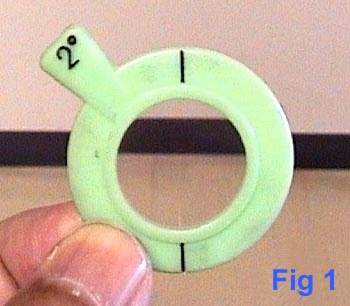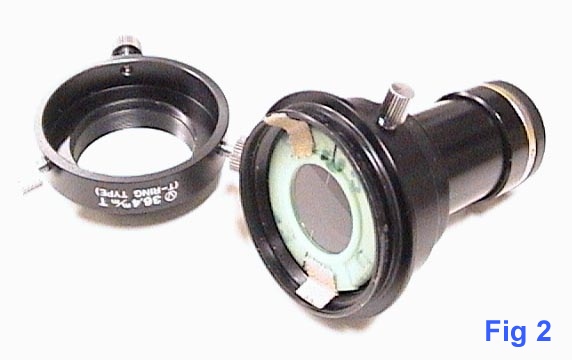Great 2003 Mars Coming (08)
Great 2003 Mars Coming
(8)
Recommendation of the Use of the Wedge-Prisms
Teruaki KUNAMORI (Narrated by M MINAMI)
Japanese
0. Introduction
 Here Teruaki KUMAMORI, based on his experience in 2001, recommends us to use a set of wedge prisms to shoot the 2003 Mars since the planet remains lower in altitude seen from the Northern Hemisphere.
Here Teruaki KUMAMORI, based on his experience in 2001, recommends us to use a set of wedge prisms to shoot the 2003 Mars since the planet remains lower in altitude seen from the Northern Hemisphere.
1. Light Dispersion in Atmosphere
It is well known that the propagation velocity of the electromagnetic wave in a physical medium depends on the wavelength, and this process causes the dispersion of light. When a celestial body stays at a low altitude in the sky, its sheaf of light-beam reaches us as much more degraded since the atmospheric layer through which the light passes is much thicker. The longer wavelength signal rather goes straightforwardly while the shorter wavelength one is sent more refracted. The coloured markings on any planet thus become blurred when they reach our telescope because of colour dispersion when the planet shines low in the sky.
2. Low Mars
Mercury and Venus are always low, and so we are well acquainted with the bad effect of light dispersion. We don't however pay attention to this problem concerning the outer planets since they are assumed to become at a high altitude in the sky. This is not however true since any planet haunts around Scorpion or Sagittarius if observed from the mid-latitudes of the Northern Hemisphere. For instance, the planet Mars in 2001 and 2003 is just above the horizon by about 30°~40° seen from Japan.
KUMAMORI confesses that he was not seriously aware of this fact until he became to make use of a 60cm Cassegrain at the Sakai City Observatory: By the use of this power, he turned however to recognise the effect of the light dispersion to his images even if the planets become considerably higher at an altitude of 60°.
To compensate this dispersion, it is an idea to use an optical wedge or wedge-prism (wedged shaped piece of optical glass) by reversing the direction of the dispersion. KUMAMORI was successful in producing good images of Mars in 2001 by the use of the prisms, and so he describes here his method of compensation by the use of wedge prisms (used by opticians for example) as a still appropriate method in the 2003 Mars observations.
3. Use of the Wedge Prisms
KUMAMORI (located at 34.5°N) uses optical wedges if the planet is still lower than the level of the 60° altitude. The 2003 Mars is apparently the case. In the case of the 60cm Cass he uses, he employs a wedge-prism of angle 3° if the altitude is 60°~40°, and of angle 5° when it is lower than 40°. Here the angles 3° and 5° don't imply the wedge angles or vertical angles, but deviation angles (determined from the wedge angle and the refraction index). One of the photos attached shows a 2° round wedge prism pinched by fingers. (Fig 1)
 KUMAMORI puts the prism just in front of the eyepiece that he uses to lengthen the focal length; an eyepiece called XP 24mm (Pentax Optics) in the Mars case. The direction of deviation is put perpendicular to the horizontal line. In the case of Newtonian, however, the choice becomes somewhat complicated. Note also that the distance of the prism from the eyepiece also affects the deviation, and so the deviation angle to choose must be different from system to system. (Fig 2)
KUMAMORI puts the prism just in front of the eyepiece that he uses to lengthen the focal length; an eyepiece called XP 24mm (Pentax Optics) in the Mars case. The direction of deviation is put perpendicular to the horizontal line. In the case of Newtonian, however, the choice becomes somewhat complicated. Note also that the distance of the prism from the eyepiece also affects the deviation, and so the deviation angle to choose must be different from system to system. (Fig 2)
4. Remarks
KUMAMORI uses a video camera to collect hundreds of images to stack, and so the use of wedge prisms from the outset is inevitable to compensate the dispersion. In the case of the cooled ccd camera, one may think that the three-coloured decomposition will cancel the dispersion by focusing each ingredient, but KUMA- MORI is of the opinion that each component has a width (of about 100nm), and hence it is advisable to use also a wedge-prism for each component. KUMAMORI also advises that since the leakage of the IR light to the Blue range makes the resolution to be lower, one should use a good IR blocking filter in addition to the wedge prism.
KUMAMORI also writes about his experience on the necked eye observation of the planets by the 60 cm Cass: He assures that the use of the wedge prism when the planet is at the altitude of 30°~40üŗ brings a better seeing as well as contrast by one grade. However in the use of a refractor, though he is not so experienced, the effect of the use of the prism does not so show up because of the intrinsic chromatic aberration.
At any rate, KUMAMORI is very sure about the good effect of the use of the wedge-prisms, and thus recommends the Mars observers in the NH to employ this method in the 2003 apparition.
Back to CMO #269 Home Page
Back to the CMO HP / Back to the Façade
 KUMAMORI puts the prism just in front of the eyepiece that he uses to lengthen the focal length; an eyepiece called XP 24mm (Pentax Optics) in the Mars case. The direction of deviation is put perpendicular to the horizontal line. In the case of Newtonian, however, the choice becomes somewhat complicated. Note also that the distance of the prism from the eyepiece also affects the deviation, and so the deviation angle to choose must be different from system to system. (Fig 2)
KUMAMORI puts the prism just in front of the eyepiece that he uses to lengthen the focal length; an eyepiece called XP 24mm (Pentax Optics) in the Mars case. The direction of deviation is put perpendicular to the horizontal line. In the case of Newtonian, however, the choice becomes somewhat complicated. Note also that the distance of the prism from the eyepiece also affects the deviation, and so the deviation angle to choose must be different from system to system. (Fig 2) Here Teruaki KUMAMORI, based on his experience in 2001, recommends us to use a set of wedge prisms to shoot the 2003 Mars since the planet remains lower in altitude seen from the Northern Hemisphere.
Here Teruaki KUMAMORI, based on his experience in 2001, recommends us to use a set of wedge prisms to shoot the 2003 Mars since the planet remains lower in altitude seen from the Northern Hemisphere.